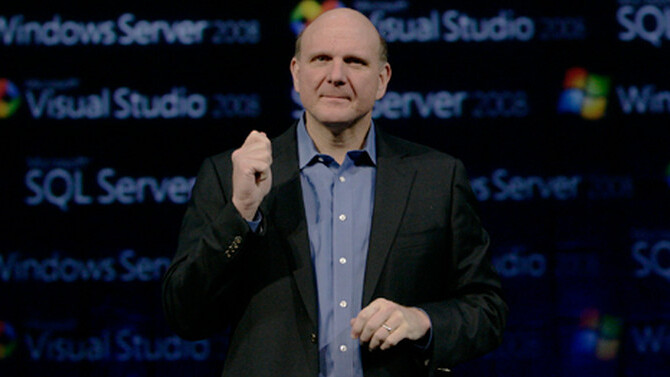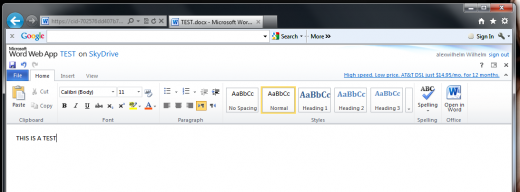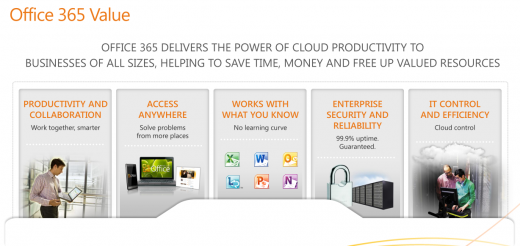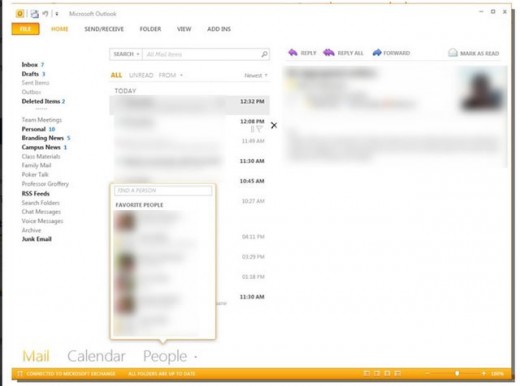
Productivity software forms the crux of daily tasks for many of today’s workers, no matter what field they find their employment in. The reigning king of productivity suites, Microsoft Office, is the market participant to beat, and Google is lining up to do just that.
As we take stock of the present, and look into the future, will Microsoft Office retain its throne, or will more nimble, lightweight online software take its place? It’s a billion dollar question, so let’s get started.
The Present:
Office 2010 has been an engine of growth for Microsoft since it came out in the middle of last year, driving up both profits and revenues. If Office 2007 was controversial, with its ‘Ribbon’ design interface, Office 2010 has managed to shake off that stigma and become a user favorite in homes and workplaces alike.
But Office 2010, and its sister suite Office 2011 for Mac, are hardly the only productivity products that Microsoft is hard at work on, even if they are the most popular and best known.
Office Live, Microsoft’s oldest ‘cloud’ productivity solution in its current form barely resembles its past. Born in 2006, around the time of Vista, Office Live was a tool for small businesses to get online. For free, a small company could get a half gigabyte of storage, 25 email accounts, corporate instant messaging, and a domain name. Obviously, it was a hit among ever-frugal minor enterprises.
But Microsoft had different plans for Office Live. The product was stripped of its small business focus, and the Office files that users had uploaded were moved to SkyDrive. In October of 2008, at the Professional Developers Conference in LA, Microsoft announced that Office Web Apps would be available through Office Live in the future. After a lengthy waiting period, in June of 2010, a mere eight days before the formal release of Office 2010, Office Web Apps went live.
The transition from Office Live being a small business resource into a consumer facing product that serves lightweight versions of the full offline Office suite was then complete. If you head to officelive.com now, you are greeted with a bold call to try out Office Web Apps. Office Live is now, to all intents and purposes, Cloud Office.
For reference, this is what Word in the cloud looks like:

It is a usable product, if you don’t need to do anything to complex, data intensive, or large. As with other cloud offerings, such as Google Apps (more on that later), Office Live is not a daily use suite for the professional in need of power.
Microsoft, however, has another iron in the fire. The small business aspects that once had a home in Office Live did not die off completely, but went into hibernation. In the last week, Microsoft released the hotly anticipated beta of Office 365, the spirit-child of the old Office Live, a new product that includes Exchange Server, SharePoint server, Lync server, and Office 201o. Its feature set is far richer than what was offered in the original Office Live line, but it comes with a price tag; Office 365 has no free tier, whereas the point of Office Live was its zero cost.
To quote Microsoft:
“Office 365 is the best of everything we know about productivity, all in a single cloud service. With Office 365, your local bakery can get enterprise-caliber software and services for the first time, while a multinational pharmaceutical company can reduce costs and more easily stay current with the latest innovations. People can focus on their business, while we and our partners take care of the technology.”
Office 365 also includes a hosted version of Office Web Apps, bringing the cloud into the new small business suite. But for many companies, that might be somewhat troublesome if they are more conservative as to where employees can store and interact with data. Microsoft has a plan in place for that, allowing companies to host their own set of Office Web Apps on their internal SharePoint server. This is a middle solution, as using the internally hosted cloud apps away from the office carries technical difficulties.
To make it simple to understand, the following two slides are right out of the deck that Microsoft uses to pitch 365:


In typical form, adding complexity at every turn, Microsoft has manged to break its productivity products into three lines: the standard, local, Office suite of applications for OS X and Windows; Office Live with Office Web Apps where consumers can use their Live IDs and SkyDrive to host and edit documents and other files online; and Office 365, the small business solution that includes the best of Microsoft’s enterprise tools as at a lower price level, alongside hosted or self-hosted Office Web Apps.
If you didn’t get all of that, it’s fine, you don’t need to know each granular piece. Just understand that Microsoft is trying to reach all parts of the market with products that are tailored to fit. If in fact they can pitch the correct product to the correct channel, Microsoft’s strategy could be quite successful. If not, Microsoft might have spent untold sums on more than one albatross.
The Competition:
Google. In a word, that is what Microsoft is up against. There is of course the market presence of Open Office to be considered, but anyone who has used the suite can attest to its functional poverty. Also, as it lacks a cloud solution, it is nearly moot for this discussion.
Google is the threat that Microsoft is responding to, competing with, and determined to beat in the cloud. What Microsoft provides with Office Live/Office Web Apps to consumers, a free hosted suite of Office apps and free storage, I would argue, could never have been built or released by Microsoft if Google Apps had not picked up miles of ground with consumers.

But the threat hardly ends there, Google has a full suite compiled for both small, medium, and enterprise sized businesses, at a compelling price point of $50 per user per year; Google is not only going after the soft consumer underbelly that has always used Office but might be willing to switch to Google Docs (et al), but also the ironclad domain of Microsoft: corporate productivity applications.
It is this threat that keeps the Office team up at night.
Now, no one in their right mind would ever say that Google’s document editing capabilities are anything like on the same level as what Microsoft offers in Word, but Google is wagering that it does not matter. To the everyday consumer, do they truly mind the lack of features if it’s accompanied by a massive price decrease?
And that is why Office Live/Office Web Apps are watered down versions of Microsoft’s greater Office suite: the company has to offer something to stave off Google’s Apps and keep users familiar with the Office setup and layout, all the while not giving them reason to either move to Google, or to not purchase Office 2010 if they need more power.
Of course Google knows all of this, and is likely determined to use every tool its box (Chrome, Search, etc) to push Google Apps, all the while improving its core functionality to reach a less intensive inverse parity with Office 2010.
However all of this is right now – what will happen next?
The Future:
To Microsoft, they own the future. When Office 2010 was released, this is what Stephen Elop, the then president of Microsoft’s Business Division, said: “Office 2010 and SharePoint 2010 define the future of productivity.” Is that the case?
The next few years of struggle between Microsoft and Google in the productivity space was outlined in a recent squabble over FISMA (Federal Information Security Management Act) certification. FISMA, a somewhat arcane and decidedly specialized certification that ensures that an application or suite is safe enough for governmental use, is all but required for any tool to be adopted by the Federal Government.
Google claimed that its Google Apps for Government product was FISMA certified. Microsoft called them down on it, and the DOJ seems to agree. Google shot back that Microsoft was full of beans, and was writing “breathless” blog posts on the matter. When a company goes ad hominem, you know that a nerve has been touched. To Google: “[Microsoft’s] allegations are false.” Then days later Microsoft’s Business Productivity Online Suite for governments (BPOS-Federal) [its competitor to Google Apps for Government] received, officially, FISMA certification.
And now its off to the races. Google needs to clear up its FISMA status and start landing government contracts, as Microsoft just picked up the Department of Agriculture and over 100,000 employee accounts.
The dogfight is only going to become more vicious.
But Google might have an edge in the long-term. Microsoft is dumping money into the development of Office 15, not Office 2015, but the 15th version of Office that will follow Office 2010. Google has a singular focus on apps in the cloud, while Microsoft is dividing its attention three ways (as we saw before) between normal Office, consumer versions of Office Web Apps, and Office 365. Now Microsoft has the manpower and resources to do that, but if it can effectively evangelize those products remains to be seen.
What follows is a screenshot of Outlook from Office 15. Note how it has taken on the Metro design ethos while staying true to its roots. Microsoft is not sacrificing tradition, but seems determined to combat calcification:

Every thinking person hates the term, ‘the cloud,’ as it is roughly bandied about to describe products and services that we would have called merely ‘online’ two years ago. But that aside, this Internet thing that we all know and love is not going anywhere, and so long as Microsoft is investing heavily into Office 2015 it is betting that the total domination by the Internet over installed software is in fact still a way off. Maybe, and maybe not, but that is Microsoft’s wager.
TNW’s View:
What Microsoft currently has in terms of products is strong. But what Google has on offer is fast, slick, and user-friendly. Moving from Word to Google Docs is not hard, assuming one is familiar with Office 2003. And, despite the strides that Microsoft has made, the real-time collaboration of Google Apps is without parallel.
Microsoft needs to take the perspective that every element of its various lines of Office need to beat Google Apps at its own game at every turn, or Google Apps will always have an edge somewhere compared to what Microsoft is selling. Office Web Apps integrated into Hotmail is not nearly enough to stem the Juggernaut of growth that is Google Docs, for example.
Still, Office 2010 has sold so strongly because it is an amazing suite of applications, and is in fact the best version of Office of all time. But as the world goes lightweight, free, and ‘cloud,’ that might not carry the same importance as it did in yesteryear.
Google and Microsoft both want to control a market worth billions, and Microsoft is loath to lose its crown. But then again, who truly expects Microsoft to out-innovate Google in the cloud?
No matter which giant wins in the end, we consumers are sure to benefit from the struggle, and that is a very encouraging thought. Sound off in the comments if you think that Microsoft is going to stay in charge, or lose to the upstart Google.
Get the TNW newsletter
Get the most important tech news in your inbox each week.





